Dr Vino's wine blog
wine talk that goes down easy
Box wine: responses to your comments on Drink Outside the Box
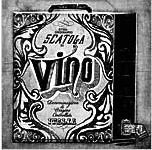 Thanks so much for the reactions to my op-ed, “Drink Outside the Box,” in Monday’s NYT. The interest astonishingly drove it to the #1 most emailed story on nytimes.com! (And then some guy named Mikhail Gorbachev came along and knocked me off the list.) With the interest has also come reactions and I thought a post was in order to respond to some of the many important issues you raised both on the previous posting on this site as well as in the comments section on the Times’ site.
Thanks so much for the reactions to my op-ed, “Drink Outside the Box,” in Monday’s NYT. The interest astonishingly drove it to the #1 most emailed story on nytimes.com! (And then some guy named Mikhail Gorbachev came along and knocked me off the list.) With the interest has also come reactions and I thought a post was in order to respond to some of the many important issues you raised both on the previous posting on this site as well as in the comments section on the Times’ site.
One point I’d like to underscore is that by far the majority wines in the US are consumed, oh, about an hour after purchase. There’s a joke in the wine trade that we Americans do have wine cellars–they’re called the back seat of the car.
Another important point is about freshness. Wine bottled with cork closure can be with oxidized or, worse, plagued by TCA, also known as cork taint, which afflicts annoyingly high percentage of wines–nobody knows for sure, but one bottle per case is certainly a plausible guess. Do you really want to donate eight percent of your wine budget to spoiled wines gods? For box wine, this is not an issue since there is no cork.
Finally, I’m really excited that nine out of every ten respondents in the poll say they would try good wine in a box. I think wine consumers–or a strong subset of consumers–are really ahead of the trade on this issue. With good wine, box wine’s longtime stigma can be used as a counter-culture sign of hipsters!
Okay, let’s roll with your questions and comments about recycling, aesthetics, wine picks, and more!
How is putting wine in a plastic bag with a plastic spigot more environmentally friendly than using recyclable glass?
— GG, Minnesota Read more…
An $18 bubbly showdown: Puzelat vs Strohmeier
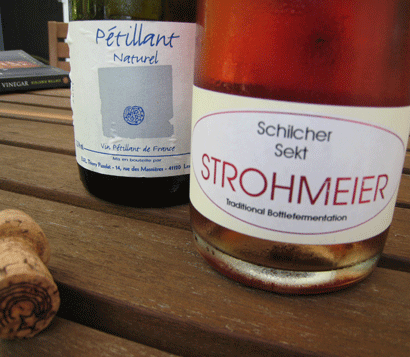
An $18 bubbly showdown! Well, it was and I didn’t even plan it. Some friends came over recently and we each had a bubbly ready to go. So what are wine lovers to do? Why, open them both, of course!
First up, from the Loire was Thierry Puzelat, naturalista wine maker who made it through to the quarterfinals in the Wine Madness tourney back in March. I was ready for Thierry to bring the shazam since I am a fan of his wines. But the cork on the Vin Pétillant de France Naturel Non-dosé released with a whimper rather than a bang. The mousse–the foamy part–was weak! This pétillant did not have the gas (literally) to keep it frothing! Upon tasting, it was more like cider than Champagne–that non-dosé stuff can be tough to make. A bummer! One person dumped her glass! (Ahem!) Puzelat, upended! Shades of Wine Madness all over again!
Then it was on to the Strohmeier…I mean come on, who’s ever heard of Strohmeier? They’re an Austrian producer founded in 1990, which is practically a New World time frame. And it’s not even from the esteemed Wachau–it’s from Styria! Some southern part of Austria that has produced, among other things, the Governator! And the grape in this Schilcher Sekt nonvintage–Blauer Wildbacher? Let’s get serious! Now to the pour: major mousse! Frothing all over the place. Bright pink effervescence in the glass! Now on to the taste. Oooh, it’s got hints of strawberry, it’s juicy, it’s got good acidity–in short, a delightful summer sipper on the deck! No glasses dumped on the geraniums! Strohmeier takes home the trophy in this spontaneous $18 bubbly showdown!
Find the Puzelat petillant
Find the Strohmeier Schilcher Sekt nonvintage
Six natural wines for summer
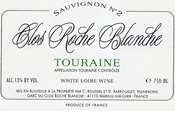 Hot weather. Cold wine. And patchouli.
Hot weather. Cold wine. And patchouli.
That’s the subject of a short piece that I did for the new Hearst website, The Daily Green. Well, OK, I didn’t get to mention any patchouli. Click through and see the six “natural” wine producers that I did mention!
Actually, here, I’ll spare you the click through and list them here. But you still have to click through for the pretty slide show and descriptions! One day I’ll learn how to do a slide show here…
Clos Roche Blanche, Touraine, sauvignon blanc 2006 (about $14, find this wine)
Albert Mann, cremant d’Alsace (sparkling pinot blanc; about $20 find this wine)
Ocone Falanghina del Turbano, 2007 (find this wine)
Cooper Mountain, pinot gris 2006 (about $15, find this wine)
Porter Creek, Fiona Hill Vineyard, Russian River Valley, pinot noir. (about $39, find this wine)
Chateau Oupia, Minervois, 2006. (about $10, find this wine)
Kickin assyrtiko in Santorini
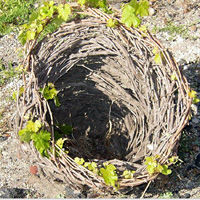 I had a wine that came from a nest today. The vineyard manager would probably call it basket or even ampelies. But to me it looked like a nest. Granted, I was only looking at a photo–if only I could have arranged a field trip to the vineyard.
I had a wine that came from a nest today. The vineyard manager would probably call it basket or even ampelies. But to me it looked like a nest. Granted, I was only looking at a photo–if only I could have arranged a field trip to the vineyard.
Blown to bits by a volcano in 1640 BC, the sliver of a Greek isle that is today Santorini has many old vines. They struggle. They cling to the earth. And the vineyard workers prune them into these nest/baskets intentionally to help them against the elements, notably the near-constant wind blowing over the treeless slopes. The other element is water. The vines survive the scorching summer days by collecting moisture in the nests at night when the fog rolls in. Sounds quite dramatic and I’ll have to check it out with Mrs. Vino one day. And the sunsets. And the food. But back to the wine!
Domaine Sigalas, Assyritiko-Athiri 2007, $16 (find this wine)
This dry wine has a nice creaminess on top of good acidity that makes it extremely user friendly. The importer, Ted Diamantis, told me that it’s the Athiri grape that gives it that richness. The Domaine farms organically.
For wine geeks, the other wine, a straight assyritiko varietal wine (find this wine), has some off-the-charts briney qualities with a faint smokiness and minerality–the gout de terroir of Santorini, no doubt. Ted suggested pairing it with shellfish with high iodine-levels, like oysters. Sounds like a plan.
In lieu of their own winery website, here’s a link to Domaine Sigalas on the useful site All About Greek Wine.
Check out a nice pic of a Santorini vineyard over here.
From Japan, observations about wine, carbon and classrooms
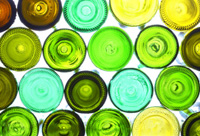 An MIT professor whose research focuses on energy and the environment is currently teaching Masters students in Sustainability Science at the University of Tokyo. He contacted my co-author and me about our research into the carbon footprint of wine since he wanted to assign his students the same task but tracking three bottles of wine to Tokyo instead of to Chicago, as we had done.
An MIT professor whose research focuses on energy and the environment is currently teaching Masters students in Sustainability Science at the University of Tokyo. He contacted my co-author and me about our research into the carbon footprint of wine since he wanted to assign his students the same task but tracking three bottles of wine to Tokyo instead of to Chicago, as we had done.
They tracked three hypothetical bottles from California, Australia and France and varied the mode of transport, with California going by air and the other two using shipping. Their results mirrored ours showing that the mode of transportation matters and that the mass of packaging also plays a role. Several students proposed that wine be shipped in bulk and bottled at the point of sale or consumption. He also added this detail:
The class discussion was concluded with an experimental component in which the students had the opportunity to sample a Yellowtail Cabernet Sauvignon (2005), Muscadet de Sevre and Maine (Loire, 2006), and a Ravenswood Zinfandel (2005, actually Sonoma + Mendocino but that is close enough to Napa). They agreed that (1) this made the assignment more interesting and (2) there are factors other than carbon emissions that should be taken into account when choosing wines.
I’m glad they enjoyed the research!
On a related note, the NYT ran a graphic with some of our findings in the excellent recent article, “Movable Feast Carries a Pollution Price Tag,” by Elisabeth Rosenthal.
Poll: Styrofoam or cardboard for your wine shipping?
“I have too much Styrofoam.” That was the “problem” that a wine writer confessed to while introducing himself at a recent wine writers conference.
 There comes a point in the wine lovers’ evolution where getting wine from the local store just won’t suffice. We want a certain bottle, sometimes from the winery or sometimes from a store that offers a better price. So we have the wine sent by UPS or FedEx.
There comes a point in the wine lovers’ evolution where getting wine from the local store just won’t suffice. We want a certain bottle, sometimes from the winery or sometimes from a store that offers a better price. So we have the wine sent by UPS or FedEx.
Of the boxes I receive, about half are filled with Styrofoam and about half with cardboard inserts to protect the bottles during transportation. In honor of Earth Day, which is the “greener” material?
My collaborator Pablo Paster calls it “a philosophical choice.” That’s because Styrofoam is much lighter than cardboard thus the box emits fewer greenhouse gases during transportation (though its manufacture emits 8.6 times the equivalent amount of cardboard says Pablo). Even though it can be recycled, it rarely is; new polystyrene is so cheap to manufacture. Thus it ends up in landfills where it takes up a lot of space and needs hundreds of years to break down. Cardboard can be recycled more readily. Both can be reused but probably aren’t reused more than once or twice.
Since I’ve expressed my opinions about the dreaded Styrofoam before, I’ll put the question to you: Which packaging material do you prefer, cardboard, with higher GHG transport emissions today, or Styrofoam, which doesn’t biodegrade?
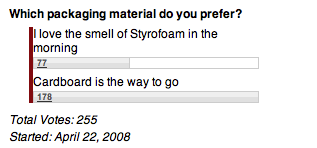
Yellow + blue make green: a new organic malbec in TetraPak
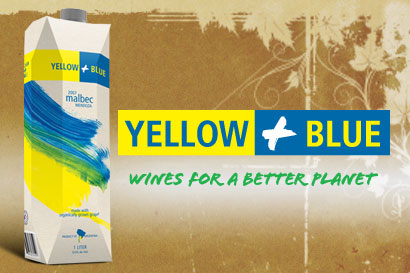
A new wine made from certified organic Malbec grapes will soon be available in the United States. But instead of a bottle, the wine will use lightweight packaging known as TetraPak, traditionally associated with juice boxes, in the name of lowering its carbon footprint.
Matthew Cain, regional sales director for fine wine importer Kermit Lynch for nine years, will be importing the wine through his new company, J. Soif. “Over a period of time I came to the realization that the wine business just doesn’t work,” he told me in a telephone interview last week. “Eighty percent of wine is drunk within a week. It doesn’t make sense to put nine liters of wine in a 40 pound box and ship it thousands of miles.” Read more…
Shaken not stirred, the mother of all wine runs
Site reader Conrad sent in this picture of the Belem under full sail. As you may recall, the three-masted barque (schooner?) built in 1896 has been enlisted to transport wine from Languedoc to Ireland with a zero carbon footprint.
Sail.ie recaps the story and has the excellent picture. As a green enthusiast, I think it’s a cute, if somewhat headline grabbing effort (barque worse than their bite?). But as a wine enthusiast, whoa, if the boat’s a rockin’…




